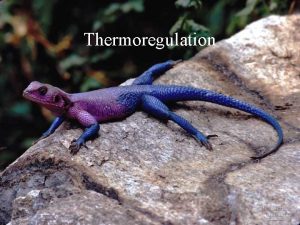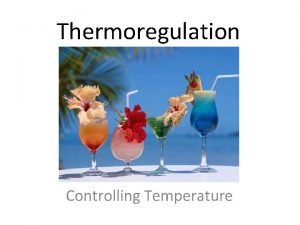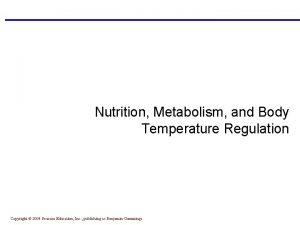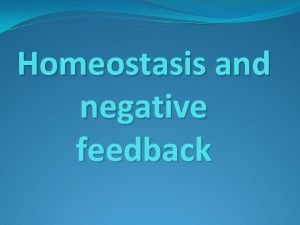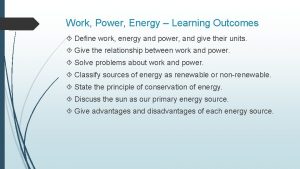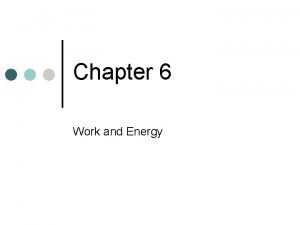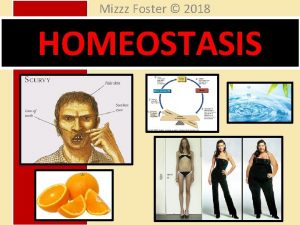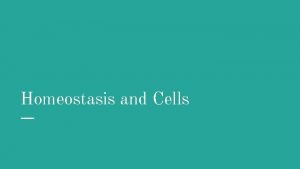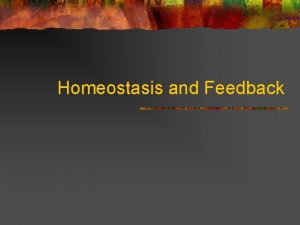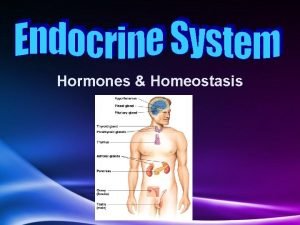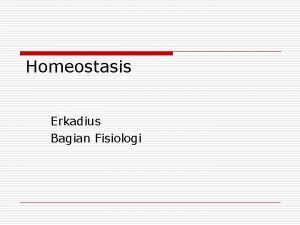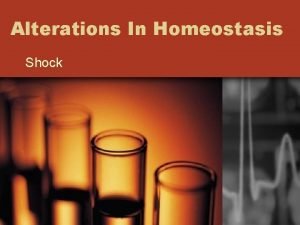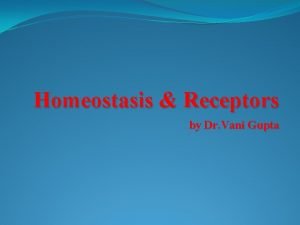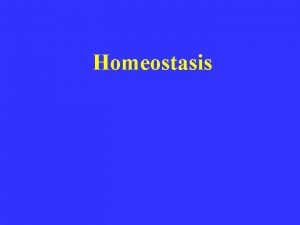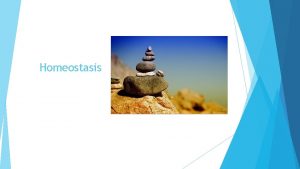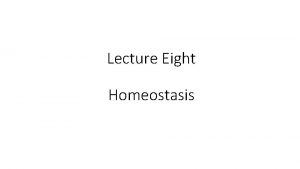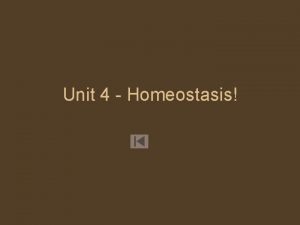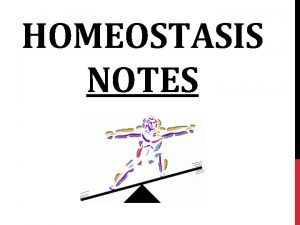Homeostasis Concept and Regulation Specific learning outcomes Define


















- Slides: 18

Homeostasis Concept and Regulation

Specific learning outcomes �Define homeostasis. �Explain the concept of Homeostasis and its consequences on the human body

Internal environment Claude Bernarde introduced the term internal environment / Milieu interieur for ECF of the body � Body cells essentially depends on ECF for maintenance of cellular life �

Homeostasis W B Cannon (constancy of the internal environment is maintained and ensured) � Living membranes with varying permeability's such as vascular endothelium and cell membrane play important role �

Factors involved in maintenance of homeostasis �Maintenance of p. H of ECF (acid base balance) �Regulation of temperature �Maintenance of water and electrolyte balance �Supply of nutrients, oxygen, enzymes and hormones �Removal of metabolic and other waste products

Role of different systems of the body in homeostasis �Transport of ECF : Circulatory system for continually being mixed and maintaining homogeneity �Supply of oxygen and nutrients to ECF: must for growth of tissue, respiratory system, digestive system, circulatory system, MSK system ◦ Hormones play role in metabolism of nutrients and other substances

�Removal of metabolic end products and waste: kidneys, respiratory system for removal of carbon dioxide from the body �Water and electrolyte balance: combined efforts of kidney, skin, lungs, salivary secretion, and digestive system �PH of blood and acid base balance: respiratory system, kidneys, blood and buffer systems in the body

�Temperature : combined efforts of skin, cvs, respiratory system, digestive system, excretory system, skeletal muscle system and nervous system �Regulation of body functions: nervous system and hormonal system

Mode of action of homeostatic control system �Feedback mechanism ◦ Positive feedback ◦ Negative feedback �Adaptive control system

Negative feedback mechanism �Most control system of body act by this. �When activity of particular system increases or decreases, it initiates a negative feedback so as to return towards normal

Examples �When BP suddenly rises or lowers, it initiates a series of reactions that tries to bring the BP to normal levels �When thyroxin secretion is more, it inhibits the secretion of TSH from pituitary so that thyroxin is not secreted from thyroid gland

Positive feedback mechanism �Some times causes vicious circle and harmful �Mild degree of feedback can be overcome by negative feedback mechanism, and vicious cycle fails to develop

Positive feedback mechanism causing death

Positive feedback mechanism which are useful �Child birth during labour is facilitated by progressive increasing uterine contractions due to positive feedback from stretching of cervix by head of the baby �Clot formation following rupture of vessels is accelerated by vicious cycle of thrombin formation which stops bleeding

Parturition reflex

Adaptive control system �Delayed type of negative feedback mechanism seen in nervous system �Example: when some movements of body occurs very rapidly, there is no enough time for nerve signals to travel from peripheral parts of body to brain and then back to periphery again to control movement

�In such conditions, brain uses feed forward control to cause required muscle contraction �Which retrospectively is conveyed to brain by sensory nerve signals from moving part �If movement performed is incorrect, then brain corrects the feed forward signals that it sends to muscle the next time the movement is required

Reference Indu khurana. Medical physiology for UG, 1 st edition, Elsevier publication chapter 1 page 7 -8
 Bioflix activity homeostasis low blood glucose
Bioflix activity homeostasis low blood glucose Bioflix activity homeostasis high blood glucose
Bioflix activity homeostasis high blood glucose Homeostasis mechanisms for regulation of body temperature
Homeostasis mechanisms for regulation of body temperature Negative feedback and body temperature regulation
Negative feedback and body temperature regulation Nutrition metabolism and body temperature regulation
Nutrition metabolism and body temperature regulation Homeostasis mechanisms for regulation of body temperature
Homeostasis mechanisms for regulation of body temperature Outcomes focused regulation
Outcomes focused regulation Explain general to specific ordering of hypothesis
Explain general to specific ordering of hypothesis Program specific outcomes nba
Program specific outcomes nba Planning goals and learning outcomes
Planning goals and learning outcomes Learning outcomes of reported speech
Learning outcomes of reported speech Input and output devices for visually impaired
Input and output devices for visually impaired Learning outcomes of work and energy
Learning outcomes of work and energy Learning objectives of profit and loss
Learning objectives of profit and loss Learning outcomes of work and energy
Learning outcomes of work and energy Roman number 5200
Roman number 5200 Homeostasis define
Homeostasis define Concept learning task in machine learning
Concept learning task in machine learning In the afylin framework learning outcomes are arranged
In the afylin framework learning outcomes are arranged


